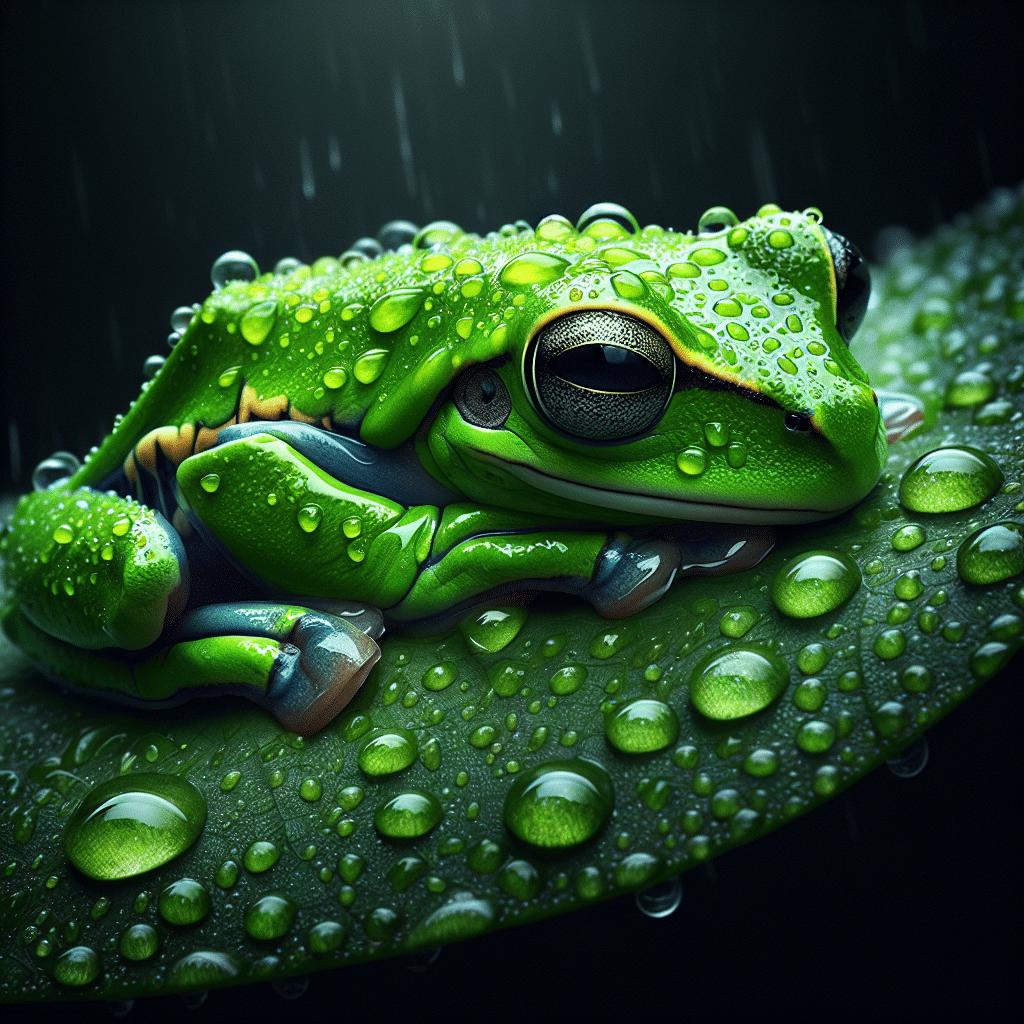If you’ve ever been curious about the slick, sometimes gooey stuff that frogs secrete, you’re not alone. It turns out, that slimy coating is more than just froggy sunscreen. In reality, these secretions are a fascinating cocktail of compounds with a variety of functions, from keeping their skin moist to defending against predators. Some frogs take it up a notch, producing substances that have piqued the interest of medical researchers due to their potential in fighting human diseases. So, let’s hop into the world of frogs and uncover the secrets of their skin.

Overview of Frog Secretions
When it comes to frogs, their skin isn’t just about staying slippery. As you dive into the world of these fascinating amphibians, you’ll find that they secrete a variety of substances that play crucial roles in their survival. Some secretions serve to safeguard a frog’s delicate skin in various environments, while others act as a defense mechanism against predators.
Types of Secretions
Frogs secrete mucous, antimicrobial peptides, toxins, waxy substances, pheromones, color-changing compounds, enzymes, and even healing and regenerative substances. The diversity of these secretions is incredible, and each type serves a specific purpose — from maintaining skin health to communication.
Functions of Secretions
The functions of frog secretions are as varied as the substances themselves. They can be broadly categorized into protection, hydration, communication, and physiological roles like helping with digestion or healing. These natural chemicals serve to enhance the survival chances of frogs in their competitive ecosystems.
Secretory Glands in Frogs
Your average frog is covered in numerous glands that are responsible for producing these secretions. The most notable are the mucous glands, which keep the skin moist, and granular glands, which can produce more specialized secretions such as toxins. These glands are a key component of the frog’s integumentary system.
Mucous Secretions
Composition of Mucous
Frog mucous is a gooey substance composed of water, glycoproteins, proteoglycans, and enzymes. It’s somewhat similar to the mucous you might find in your own nose and throat, but it’s specially adapted for a frog’s life on land and in water.
Role in Hydration
One of the most important roles of mucous is to keep the frog’s skin moist. This is crucial because frogs don’t drink water like you do — they absorb it through their skin. Their mucous secretion ensures they stay hydrated and can also help them breathe, as many frogs exchange gases through their skin.
Importance for Skin Elasticity
Apart from hydration, mucous keeps the frog’s skin elastic. Since frogs are known for their impressive jumping ability, flexible skin is non-negotiable. It allows for the dramatic expansion and contraction of their bodies during movement.

Antimicrobial Peptides
Definition and Purpose
Antimicrobial peptides (AMPs) are components of the innate immune system. In the context of frogs, these substances can be akin to microscopic bouncers that guard their skin against bacteria, viruses, and fungi that threaten to crash the party and harm the frog’s health.
Mechanism of Action
AMPs typically work by punching holes in the cell membranes of these microscopic invaders, essentially causing them to fall apart or explode. The peptides tend to be broad-spectrum, which means they can take out a variety of pathogens.
Clinical Potential
Given their ability to wage war against microbes, AMPs have caught the interest of the medical community. They are being explored as potential alternatives to traditional antibiotics, which is a big deal considering the growing problem of antibiotic resistance.
Toxic Secretions
Common Toxins Produced by Frogs
The toxins produced by some frogs can range from mildly irritating to seriously harmful. The poster child for this is the infamous poison dart frog, which secretes batrachotoxin — a powerful and deadly poison.
Defensive Functions
Toxic secretions primarily serve as a defense strategy. They deter predators from seeing the frog as a tasty snack. When a predator experiences the ill effects of these toxins, it learns to associate that experience with the frog’s bright coloration, and over time, avoids frogs with those colors.
Impact on Predators and Humans
For predators, the impact of these secretions can be a direct threat to their life. For humans, these secretions can also be dangerous if handled improperly. However, indigenous people have found ways to use these toxins to their advantage, such as applying them to the tips of hunting darts and arrows.

Waxy Secretions
Role in Preventing Dehydration
Some frogs produce waxy secretions that form a barrier on their skin, preventing water from escaping. This is especially important for tree frogs and others that live in dry or fluctuating environments.
Secretion Process
The process involves specialized glands that secrete the waxy substance, which the frog then spreads across its body, usually with its legs. Think of it as applying a natural moisturizer to prevent dry skin.
Variation Among Species
The type and amount of waxy secretion can vary a lot among different frog species. Those living in harsher, drier conditions tend to have more of these compounds to combat the threat of dehydration.
Pheromonal Secretions
Communication Through Pheromones
Pheromones are the invisible messengers of the frog world, conveying important social signals such as danger, mating readiness, and territory. They are the SMS of the amphibian realm, sent out into the environment via secretions.
Role in Reproduction
During breeding season, pheromones are all about attraction. They’re the frog’s way of saying, “Hey, look at me, I’m ready to mate.” These chemical cues can attract partners from afar and can be species-specific.
Identifying Sex and Territory
Pheromones can also signal a frog’s sex to potential mates and establish territories among males. This helps keep the peace, to an extent, and prevents unnecessary conflict.
Color Changing Secretions
Biochromes and Structural Colors
Color-changing secretions involve biochromes, the pigments that produce colors, and sometimes structural colors, which result from the way light interacts with the frog’s skin. This chameleon-like ability serves a few different purposes, such as camouflage and communication.
Adaptive Significance
Being able to change color helps frogs to blend in with their surroundings, making them less visible to predators and prey. It also comes in handy during mating displays, where showing off is key to attracting a mate.
Mechanism Behind Color Change
The mechanism behind color change often involves the expansion or contraction of cells containing pigments in response to environmental cues like temperature, light, or mood. Much like how your own skin might pale or blush under different circumstances.
Enzymatic Secretions
Digestive Enzymes in Skin Secretions
Some frogs secrete enzymes through their skin that have digestive properties. This might seem odd, but it’s a clever strategy for an amphibious life, helping to break down matter that may be stuck to their skin after a meal or during shedding.
Role in Metabolism
These enzymes can assist with the frog’s overall metabolic functions, contributing to the breakdown of nutrients and facilitating a healthy physiological process. It’s a way for the frog to make the most of its resources.
Interaction with Prey and Environment
The secreted enzymes can also interact with the frog’s prey and immediate environment. By breaking down organic matter, they might play a role in keeping the frog’s habitat clean or deterring smaller pests.
Healing and Regenerative Secretions
Promoting Wound Healing
Frogs are notorious for their ability to heal and even regenerate damaged or lost body parts. Some of their skin secretions have been found to promote wound healing, reducing the chance of infection and speeding up recovery.
Stimulating Tissue Regeneration
Certain secretions might stimulate the frog’s tissues to regenerate, effectively repairing damage in ways that are beyond the capabilities of human biology. This remarkable ability has fascinated scientists and could have significant implications for regenerative medicine.
Immunological Effects
The healing secretions also likely play a role in the frog’s immune response—helping it to fight off infections and recover from injuries sustained in the rough-and-tumble frog world.
Scientific Research and Applications
Studying Frog Secretions
Scientists study frog secretions to unravel their chemical compositions, understand their biological roles, and explore how they evolved. Every secretion offers a window into how frogs masterfully adapt to their ecological niches.
Biomedical Research
These natural compounds have a significant potential for biomedical research, especially as sources for new drugs. With antimicrobial resistance on the rise, frog secretions are seen as a potential treasure trove of novel antibiotics, antivirals, and other therapeutic agents.
Pharmaceutical Uses
The pharmaceutical industry has begun to take note of the value contained in frog secretions. There’s ongoing research into harnessing their properties to develop new medications for human diseases, from infection-fighting drugs to treatments for chronic pain or even cancer. As research advances, the humble frog could end up playing an outsized role in the future of medicine.



